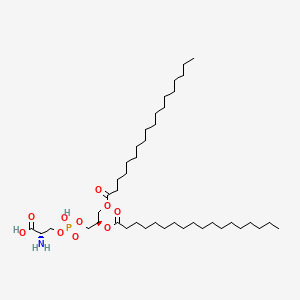51446-62-9
51446-62-9 is a lipid of Glycerophospholipids (GP) class. 51446-62-9 is associated with abnormalities such as Virus Diseases, Infection, Bacterial Infections, Communicable Diseases and Exanthema. The involved functions are known as Phagocytosis, Obstruction, Binding (Molecular Function), targeting and inhibitors. 51446-62-9 often locates in Head, Clone, Cell membrane, Cell surface and host. The associated genes with 51446-62-9 are Homologous Gene, Orthologous Gene, Fusion Protein, ETV3 gene and Amino Acids, Basic. The related lipids are Phosphatidylserines, Lipopolysaccharides, 1-palmitoyl-2-oleoylphosphatidylethanolamine, beta-amyrin and Membrane Lipids.
References related to lipids published in Others
| PMID | Journal | Published Date | Author | Title |
|---|---|---|---|---|
| 28202633 | J. Lipid Res. | 2017 | Hopiavuori BR et al. | Regional changes in CNS and retinal glycerophospholipid profiles with age: a molecular blueprint. |
| 28196959 | MBio | 2017 | Danne L et al. | Membrane Remodeling by a Bacterial Phospholipid-Methylating Enzyme. |
| 27932490 | Mol. Biol. Cell | 2017 | Chalat M et al. | C-terminus of the P4-ATPase ATP8A2 functions in protein folding and regulation of phospholipid flippase activity. |
| 27235400 | J. Biol. Chem. | 2016 | Takar M et al. | The Essential Neo1 Protein from Budding Yeast Plays a Role in Establishing Aminophospholipid Asymmetry of the Plasma Membrane. |
| 27015965 | Blood | 2016 | Biswas S et al. | Novel phosphatidylethanolamine derivatives accumulate in circulation in hyperlipidemic ApoE-/- mice and activate platelets via TLR2. |
| 26468529 | J. Virol. | 2015 | Carnec X et al. | The Phosphatidylserine and Phosphatidylethanolamine Receptor CD300a Binds Dengue Virus and Enhances Infection. |
| 26386437 | J Control Release | 2015 | Bagalkot V et al. | Hybrid nanoparticles improve targeting to inflammatory macrophages through phagocytic signals. |
| 26282427 | Antimicrob. Agents Chemother. | 2015 | Kerrinnes T et al. | Phospholipase A1 modulates the cell envelope phospholipid content of Brucella melitensis, contributing to polymyxin resistance and pathogenicity. |
| 26278183 | Chem. Biol. | 2015 | Henriques ST et al. | The Prototypic Cyclotide Kalata B1 Has a Unique Mechanism of Entering Cells. |
| 25980030 | J. Immunol. | 2015 | Zenarruzabeitia O et al. | The Biology and Disease Relevance of CD300a, an Inhibitory Receptor for Phosphatidylserine and Phosphatidylethanolamine. |
| 25921828 | FASEB J. | 2015 | López-Abarrategui C et al. | Cm-p5: an antifungal hydrophilic peptide derived from the coastal mollusk Cenchritis muricatus (Gastropoda: Littorinidae). |
| 25810252 | Proc. Natl. Acad. Sci. U.S.A. | 2015 | Xu K and Nagy PD | RNA virus replication depends on enrichment of phosphatidylethanolamine at replication sites in subcellular membranes. |
| 25377480 | Am. J. Physiol. Regul. Integr. Comp. Physiol. | 2015 | Go YM et al. | Disturbed flow induces systemic changes in metabolites in mouse plasma: a metabolomics study using ApoE⁻/⁻ mice with partial carotid ligation. |
| 25176160 | Mol. Biochem. Parasitol. | 2014 | Bibis SS et al. | Characterization of Leishmania major phosphatidylethanolamine methyltransferases LmjPEM1 and LmjPEM2 and their inhibition by choline analogs. |
| 24906800 | J. Cell. Sci. | 2014 | Hermesh O et al. | Yeast phospholipid biosynthesis is linked to mRNA localization. |
